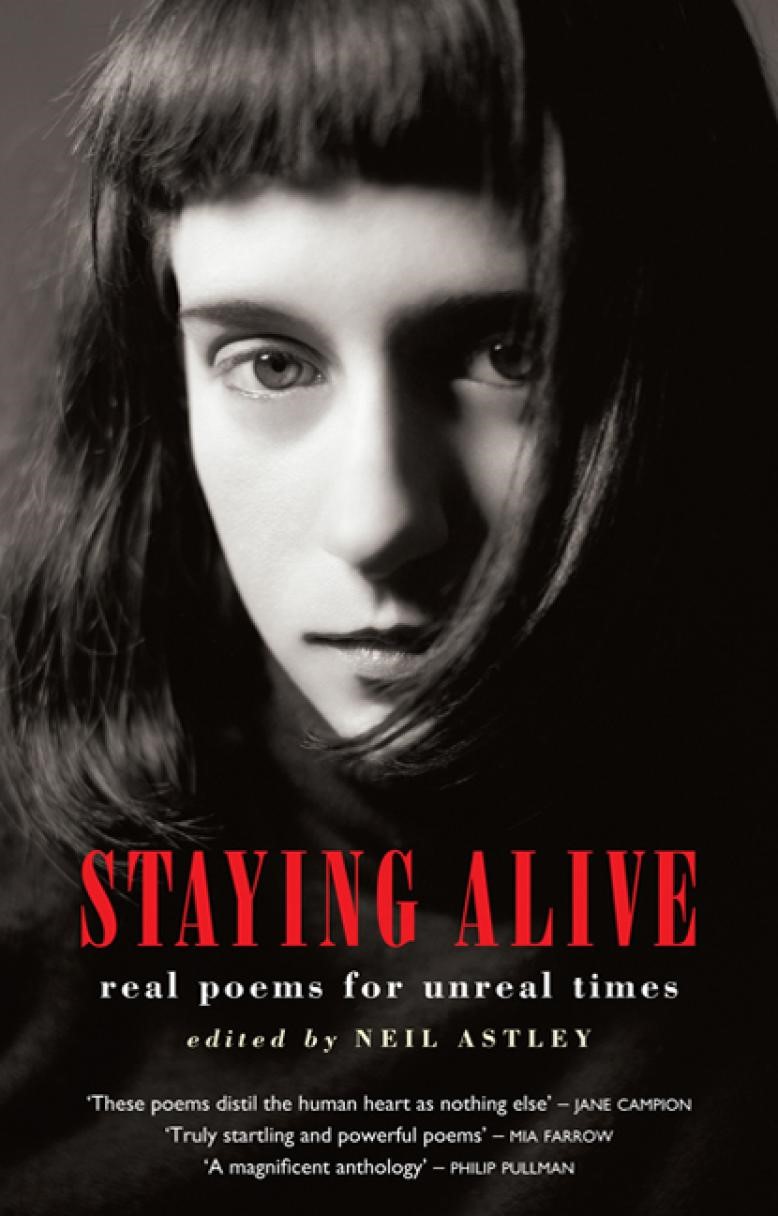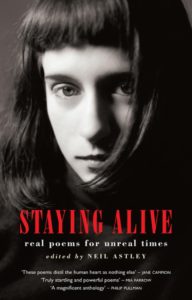
FIRST 3 ESSENTIAL BOOKS
FIRST 3 ESSENTIAL BOOKS
Staying Alive
Real Poems for Unreal Times
Neil Astley

Poetry and fiction are intertwined, and rightly so, because many craft skills required in poetry also serve fiction – take the quest to convey a message with clarity, triggering emotion in the reader or catering for reader involvement in the narrative – they are all paramount in writing poems.
I am a much better writer of stories for having gone through the process of writing a poetry collection. A chief difference between the two forms is the exigencies placed on the text due to length. Hence, just as the short story is more distilled than a novel, so the poem is more distilled than a short story. If your trouble on the page pertains to word profligacy, then this is the book for you.
Each time I delve into ‘Staying Alive’ I find new enrichment and inspiration. The publisher, Bloodaxe, has a range of strong titles worth to perusing. There are three in this particular series – the first, on display here, remains the best. All the heavy hitters have assembled within its covers. Come fraternise with Merwin, Adcock, Dickenson, Mandelstam, Plath, Frost, Bishop, Kaplinski, Brecht, Gluck, Jarrell, Olds, Neruda, Heaney, Armitage, Voigt….
‘Staying Alive’ concludes with a section devoted to further reading. By perusing such sections and tracking down some of the texts, you will have begun your collection of writing books to serve as your companions for many years.
Read some poetry, write some poetry, see where it takes you.
Making Shapely Fiction
Jerome Stern

Jerome and I go back 15 years. Here is a writer who conveys dollops of warmth, humour and wisdom in three sections.
The first is The Shapes of Fiction. ‘A shape invites you to fill it,’ Stern says. The first three demonstrate how to handle thoughts, dialogue and action – ‘techniques you’ll use over and over.’ Let’s consider them briefly.
In ‘Façade’ you take on the persona of a character and view the world through his eyes. You assume his voice and mannerisms; you write from inside him. This shape creates tension due to the discrepancy between the character’s presentation of a world and how things really are. ‘In order to embed information so that readers see more than the character, you have to have your character tell anecdotes with rich detail,’ Stern says.
In ‘Juggling’ you ‘move between action and thought to create immediacy, tension and character.’ When you have your character do one thing – washing expensive wine glasses, say, at the sink while thinking about something else: why Jane, his spouse, is behaving oddly, you add a physical dimension and you create book people. This character is handling the wine glasses roughly. We know these glasses are a wedding gift from Jane’s grandmother; hence you have inherent tension and immediacy: might he break one of the glasses? If he does, what will Jane’s response be?
The third shape is ‘Iceberg’, which focuses on what is said and what goes unsaid, what is above the water line and what below. This is demonstrated in one of the many little story-line cameos Stern writes afresh to show craft techniques in action:
Brian thought, Oh God, here it comes. My Principal. The Pig That Walks Like a Man. “Hello, sir. What a fine day”
Eiswold nodded. “What’s that on your tie, boy? Your lunch?”
“Oh, goodness,” Brian said, I hadn’t noticed. Thank you, sir.”
This interplay between thought and speech shows how thought endows fiction with an advantage over film. This technique has the scope to deepen your narratives.
Please explore ‘Bear at the Door’, ‘Onion’, ‘Visitation’, ‘Aha!’, ‘Explosion’ and the other shapes that Stern has tapped into or ingeniously devised.
‘A Cautionary Interlude’ is the second section, in which Stern points out common pitfalls that we make on our narrative journeys. Find out how to avoid Population Explosions, The Banging-Shutter Story, The Hobos-in-Space Story and more, all conveyed through Stern’s playful yet devoted approach to creative writing.
The third section is a useful alphabetical rendering of writing terms, universal ones and ones less so, like ‘Intrigant’. Stern illustrates his points in a hands-on creative style – once more deploying his trademark story scenarios. All the points are cross-referenced, so allowing you to follow the trail you embark on. For example, after the ‘Tension’ section, Stern directs us to ‘Bear at the Door’, ‘Beginnings’, ‘Endings’, ‘Plot’, ‘Suspense’ and ‘Zigzag’.
Befriend Jerome Stern! His wisdom, humour and generosity will enrich your writing.
Creative Writing, A Workbook with Readings
Linda Anderson

Refreshing to have the Brits show up in a field dominated by the Americans. This book is their answer to ‘Writing Fiction’, by Janet Burroway (next slide), the bible used in the famed writing program at the University of Iowa, except this work, running to 650 worthwhile pages, is larger in scope, going beyond fiction to poetry and life writing. ‘Creative Writing’ amounts to a full writing course by The Open University. The writers/teachers who compiled it have taught on writing programs at Lancaster University and the University of East Anglia.
Unlike the Iowa text, you are not reading short stories interspersed between chapters; rather, you are referred to excellent excerpts from novels/poems/memoirs/stories and other texts on writing in the last 200 pages of the book that demonstrate points being made.
The book considers the creative process in the first section, followed by writing fiction by writing poetry, and life writing. But it’s the readings section, with matching categories that is the highlight and distinguishing feature of this book. Here you have excerpts from novels, stories, memoirs, biographies, and professional reflections on poetry.
This is your book if you are on a budget – 650 wondrous pages of fine writing across genres, including extracts from ‘Fires’ by Raymond Carver and ‘On Becoming a Writer’ by Dorothea Brande. There is also Flannery O Conner’s noteworthy essay on writing short stories from her book, Mystery and Manners. Flannery considers character to be the flowering seed of story.
Do you need ‘Creative Writing’ and ‘Writing Fiction’? No, but it’s a treat to have both. A caution, however – when you have writing books of quality in the home, it’s easy to fall into the trap of reading about writing during hours designated for your own writing!



Sorry, the comment form is closed at this time.